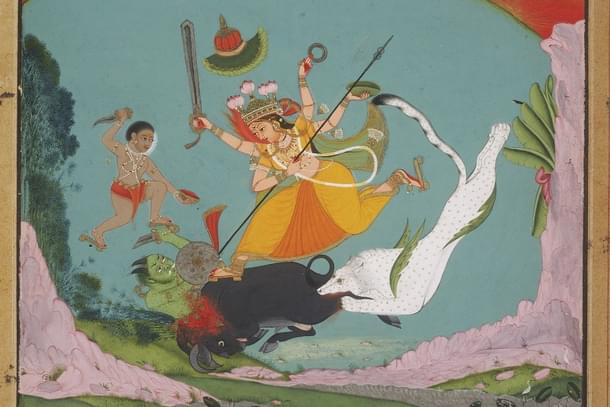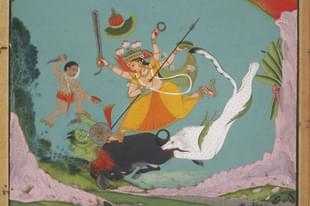Ideas
Random Meditations through Her 1000 Names: VIII
Aravindan Neelakandan
Jul 26, 2018, 01:04 AM | Updated 01:03 AM IST
Save & read from anywhere!
Bookmark stories for easy access on any device or the Swarajya app.


Read part seven here.
Ragasvarupapashadhya : Her eighth name means She who carries ragah in the form of the noose. Ragah is often loosely translated as desire. This and the next three names describe the weapons the Goddess carries in Her four arms.
Ragah is more than just desire. In his Yoga-Sutras, Patanjali defines yoga as the cessation of all vrttis- the activities and movements of the chitta. Chitta is the sum of manas, buddhi and ahankara. Though yoga aims at the cessation of all vrttis, there are inner movements which are conducive to yoga and there are others which are detrimental to the goal of yoga. These detrimental movements and activities in turn are caused by kleshas. These are five in number. They are avidya, asmita (I-ness), ragah, dvesa and abhinivesah (fear of death). According to the commentary of Vyasa, avidya is the ground from which the other four kleshas arise. While mostly avidya is translated as ignorance or nescience, Adi Shankaracharya in his Vivekachudamani equates it with maya. The terms he defines maya in include ‘avyakta’, ‘trigunatmika’, ‘para’ etc. (VC:108) These are also names of the Goddess in Sri Lalitha Sahasranama (398, 366 & 763). From the point of view of yogic psychology both ragah and dvesa are intimately associated with memory of pleasure and pain and hence with the mental activities seeking the pleasure and avoiding the pain, respectively. Both of these are rooted in asmitā (I-ness), which in turn springs from avidya.
Bhaskaraya points out that ragah, which in humans is the karmic memory based on seeking of pleasure, becomes the energy of will (iccha-shakti) for the Goddess. It manifests as the noose or the pasha. Further, through the Goddess, the ragah of worldly desires are sublimated (as in the case of the burning of Kama by Shiva). Then the desire that comes does not lead to further karmic consequences and to further branching of the ragah. Si.Ve. Radhakrishna Sastri in his commentary points this out with the analogy given in the Srimad Bhagavatam that when one centers her mind in the divine, then the desires of the person become like the boiled grains which have lost their capacity to produce further grains. (Bhagavatam 10.22.27) The same analogy is given in their commentaries by both Vyasa (YS 2:12) and Vachaspati Misra (YS 2:2). Vijnanabhikshu, an extraordinary genius of the sixteenth century whose contribution to samanvaya of Indic Darshanas needs a greater study by scholars, says in his commentary that for a liberated seeker (jivanmukta) who is still in the body, even her apparent desire will not be a klesha causing any Karmic consequence. So, in the divine, the ragah undergoes transformation.
The way Patanjali seems to consider both ragah (seeking pleasure) and abhinivesah (feat of death) as causing movements detrimental to the goal of yoga, it may make some think that there is some life-negating tendency here. But the fact that the Goddess holds the very ragah as a form of weapon should point out that it is not so. Further, later when describing the nirguna (approximately impersonal) form of the Goddess, while She annihilates tendencies like mada, moha, mamatha, paap etc., (Madanasani-159, Mohanasini-163, Mamatahantrī-165, Papanasini-167), She is said to churn both ragaḥ and the fear of death (Mrtyumathanī-181). Though She by Herself has no ragah (Nīrāgā-156) She churns it - Ragmathanī (157). So, with Her what may be originally an impediment becomes the force through which one can reach Her. She uses the very natural pleasure-seeking and self-perpetuating drives in human beings (or any organism) to make the living being realise Her.
This use of the vital forces driven by the Divine is implied by the name Ragasvarapapashadhya. This is further reinforced by the association of Asvarudha - the chieftain of the horses in the army of the Goddess with the noose. Sri Aurobindo speaks of the Vedic horse as the symbol of 'the Life energy'. According to him 'our life is a horse that neighing and galloping bears us onward and upward; its forces are swift-hooved steeds'; 'The vital powers are the motive forces that bear us on our journey and are therefore symbolised by the Horse.'
According to Brahmanda Purana, in which the Sahasranama is situated, the chieftain of the horses sprang from the noose of the Goddess on a horse called Aparajita and crores of swift horses followed her. Sri Aurobindo in his commentary on Vedic hymns to Agni points out that the horse as the 'symbol of Force ... especially of vital force ... is variously the Arvat or war-steed in the battle and the Vajin, the steed of the journey which brings us in the plenty of our spiritual wealth.'
The original meaning of pasha is also important here. It means ‘a knot’. We encounter infinite knots in Harappan culture. In many ancient natural religions around the world, the knot was the symbol of the Goddess. All that the historians studying the Divine Feminine can do in the West is make educated guesses and speculation about the relation of the knot to the Goddess tradition which they have lost in the West. For example, Anne Baring and Jules Cashford, after listing the different knots could at best speak of them being used ‘at various ceremonies with a particular ritual meaning.’ The meaning of the knot has been lost for the West. This again makes India very special. To understand the Goddess traditions all over the world, if one is to point to a nation that harbors the unhindered evolution of all the aspects of the sacred feminine, one should point to India. Only in India the association of the knot with the Goddess is not just preserved but integrated fully with the developed science of the inner self.
Aravindan is a contributing editor at Swarajya.





